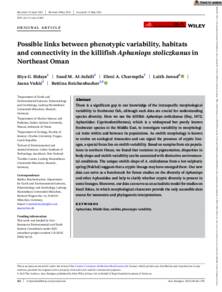Document
Possible links between phenotypic variability, habitats and connectivity in the killifish Aphaniops stoliczkanus in Northeast Oman.
Identifier
DOI: 10.1111/azo.12428
Contributors
Al-Jufaili, Saud M., Author
Charmpila, Eleni A., Author
Jawad, Laith., Author
Vukic, Jasna., Author
Reichenbacher, Bettina., Author
Publisher
Wiley Online Library.
Gregorian
2022-06
Language
English
English abstract
There is a significant gap in our knowledge of the intraspecific morphological
variability in freshwater fish, although such data are crucial for understanding
species diversity. Here we use the killifish Aphaniops stoliczkanus (Day, 1872;
Aphaniidae: Cyprinodontiformes), which is a widespread but poorly known
freshwater species in the Middle East, to investigate variability in morphologi cal traits within and between its populations. As otolith morphology is known
to evolve on ecological timescales and can signal the presence of cryptic line ages, a special focus lies on otolith variability. Based on samples from six popula tions in northern Oman, we found that variation in pigmentation, disparities in
body shape and otolith variability can be associated with distinctive environmen tal conditions. The unique otolith shape of A. stoliczkanus from a hot sulphuric
spring (Nakhal) suggests that a cryptic lineage may have emerged there. Our new
data can serve as a benchmark for future studies on the diversity of Aphaniops
and other Aphaniidae and help to clarify whether cryptic diversity is present in
some lineages. Moreover, our data can serve as an actualistic model for studies on
fossil fishes, in which morphological characters provide the only accessible data
source for taxonomic and phylogenetic interpretations.
Member of
Resource URL
Category
Journal articles

